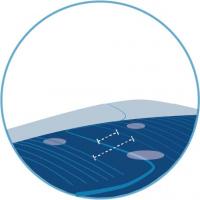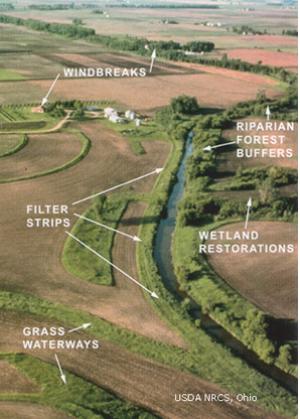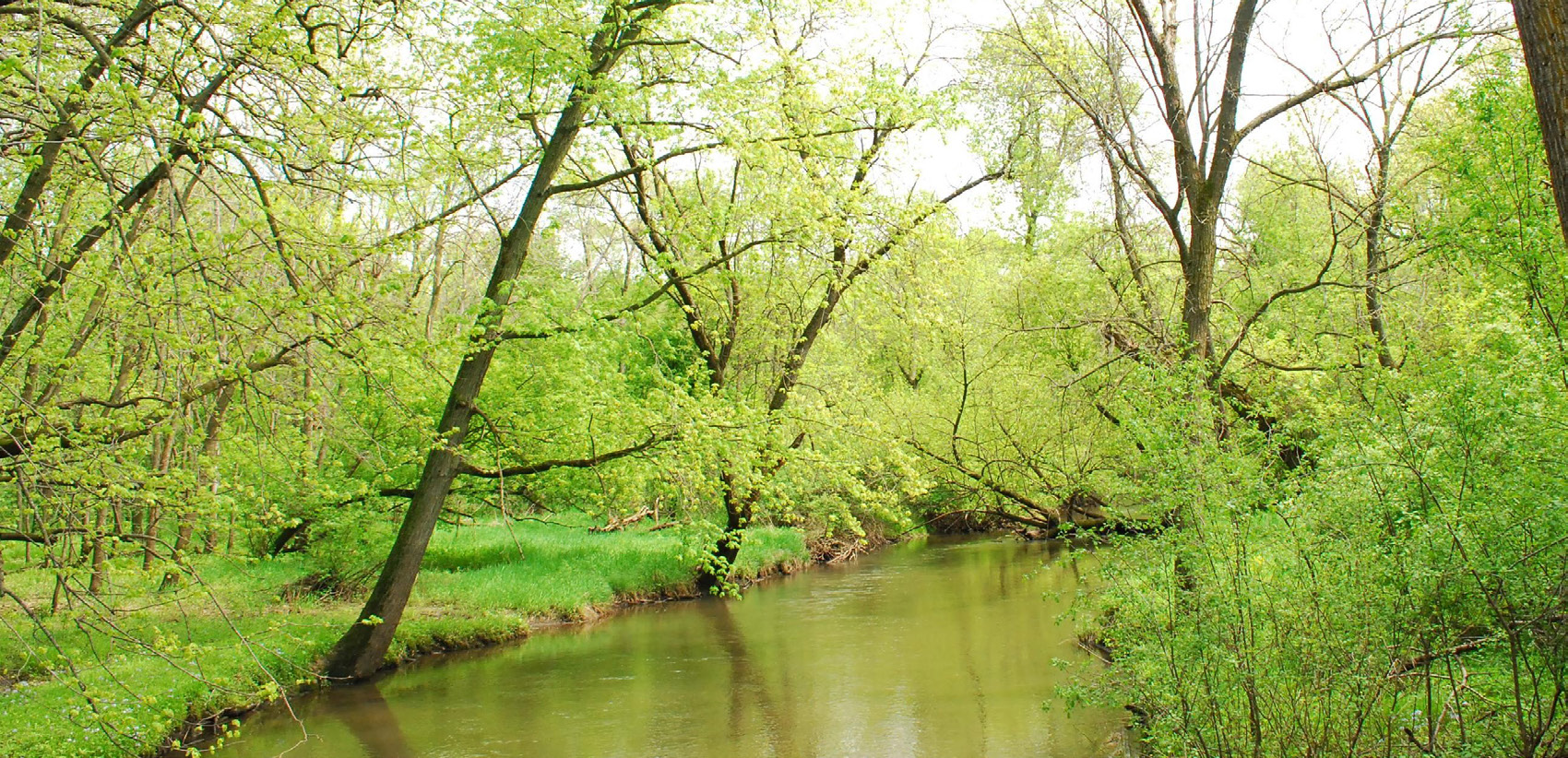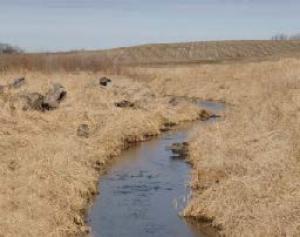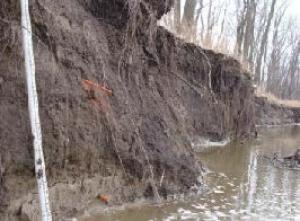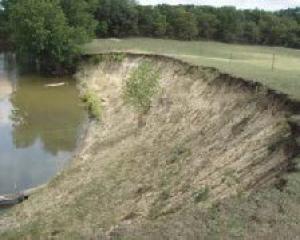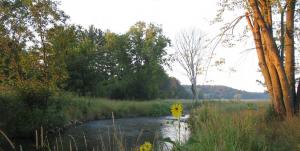Project goals and projected outcomes as well as site assessment data play into the design process. The following topics summarize basic considerations for design:
- A Systems Approach
- Designing for Multiple Functions
- Creating Connections and Corridors
- Protecting Resources
- Providing Habitat for Specific Wildlife Species
- Protecting Pollinator Populations
- The Role of Riparian Vegetation
- Planning for Diversity Levels
- Planning for Buffer Widths
- Buffer Zones
- 1. A Systems Approach
-
A landscape with a combination of conservation practices to maximize storm water treatment Combining Conservation Practices
A primary step in the design process involves determining if the project needs to be part of a larger system of BMPs sometimes called a “treatment train.” Essentially, buffers do not function when relied on as the “last defense.” A vegetated buffer along an agricultural field may be overwhelmed by frequent runoff, particularly during frozen soil conditions. Plant communities such as sedge meadows may be invaded by reed canary grass or cattail when subjected to frequent water fluctuations. Other conservation practices such as a storage basin, grass waterway, shelterbelt, living snow fence, wind break, or no-till fields may protect water quality above the riparian zone. Creating a linear retention area as part of side inlet protection can help slow water, allowing deeprooted prairie plants more time to infiltrate stormwater. The need for additional BMPs often depends on the type of pollutant that will be treated. Following is a summary of pollutants commonly treated with buffers and their design considerations.
In urban areas, series of raingardens, filter strips, detention, retention ponds, and treatment wetlands can manage large stormwater volumes and settle sediment and other pollutants that may overwhelm a riparian buffer. Stormwater models mentioned earlier under “Site Assessment” can be effective tools for assessing when additional BMPs (or modifications to existing BMPs) may be needed in addition to riparian buffers. Information about BMP design can also be found at the following links.
Minnesota Stormwater Manual NRCS Practice Standards This manual presents a step-by-step process for Low Impact Development (LID) Planning. Tables are included to assist designers with the selection of BMPs. NRCS practice standards are provided for agricultural BMPs. Practice standards provide information about the design, implementation, and maintenance of BMPs. Pollutants Design Considerations a systems approach Sediment
Sediment is detrimental to waterbodies. It can negatively affect zooplankton and invertebrate populations, interfere with fish respiration, cover and suppress aquatic communities, and transfer phosphorus that produces algal blooms. Stream bank erosion is a common source of sediment, often resulting from land use and stream channel changes.
Buffers can be effective at removing sediment but will lose their effectiveness over time if too much sediment accumulates at once. Soil stabilization practices such as winter cover crop, no-till agriculture, and contour farming should be used to settle out large particles before sediment reaches the buffer. Phosphorus
Phosphorus is a nutrient essential for plant growth, but can be harmful to aquatic systems in high levels, causing excessive aquatic plant growth and algal blooms that reduce available oxygen and light levels for aquatic organisms (eutrophication). Phosphorus reaches waterbodies through soil particles or dissolved in runoff. In addition to soil particles, phosphorus can originate from fertilizers, pesticides, cleaning products, and manure. Phosphorus carried on soil can be treated by the combination of sediment-reduction BMPs and buffers.
Dissolved phosphorus should be infiltrated as close to the source as possible. BMPs for infiltration include grassed waterways, no-till agriculture, winter cover crops, detention areas, side inlet protection, and buffers. If other BMPs are used in combination with a buffer, the buffer width could be reduced. Plants can uptake phosphorus but, unless they are harvested, the phosphorus does not leave the system. In some cases, hay fields can be incorporated on the edge of buffers as an added method of removing phosphorus. Nitrogen
Like phosphorus, nitrogen adds excess nutrients in waterbodies. Excess nitrogen is the primary cause of the dead zone in the Gulf of Mexico and are also a significant problem in groundwater supplies. Buffers reduce nitrogen levels through uptake by plants or through denitrification (anaerobic bacteria turn nitrate into nitrogen gas). Denitrification needs organic-rich, wet soil with moderate to high permeability but poor drainage. Unless plants are harvested, nitrogen is released back into the system as plants decay.
Denitrification is maximized in areas where there is high organic content in the soil and where soils stay moist. Restored wetlands are a recommended BMP in combination with buffers to effectively reduce nitrogen levels through denitrification; they are particularly beneficial when they collect water from drainage tile or ditches that would otherwise bypass a buffer. Wet detention ponds are also used for denitrification in rban areas. Pathogens
Microbial contaminants include bacteria, viruses, and protozoa and are introduced to the environment primarily through human or animal waste. Pathogens can be introduced to waterbodies from animal feedlots and manure applied to fields.
Buffers should not be relied on for pathogen control. Other BMPs such as holding tanks, feedlot runoff protection, and incorporating manure into the soil should be used in combination with buffers. Pesticides
Many pesticides damage aquatic organisms and are a concern for human drinking water supplies. The characteristics of pesticides vary greatly with some strongly attaching to soil particles and some dissolving in water. Follow pesticide labels closely to minimize damage to aquatic systems.
BMPs that infiltrate water such as grassed waterways, no-till agriculture, winter cover crops, detention areas, side inlet protection, and buffers should be combined to treat dissolved pesticides. Soil stabilizing BMPs such as winter cover crops, no-till agriculture, and contour farming will help settle out large particles before contaminated sediment reaches the buffer.
- 2. Designing for Multiple Functions
-
Lake shore buffer in Washington County provides important habitat for aquatic insects Buffers are commonly designed for wildlife and water quality benefits but there are many other benefits that can result from buffers, some of which provide financial incentives to landowners. Identify key goals for buffers early as they will influence all phases of the design process. Keep in mind that multiple goals (also called “functions” in this toolbox) may be met by a single buffer. For example, a prairie planting planned for stormwater filtering may also accomplish carbon sequestration and provide habitat for ground nesting birds. If a buffer is planned as part of a system of BMPs, even more goals can be met. The following are design considerations for a range of buffer functions:
Buffer Functions Design Considerations designing for multiple functions: Bioenergy Buffer vegetation can sometimes be used as a source of fuel through co-firing, gasification, or ethanol production. Willow, switchgrass, and prairie plantings have most commonly been used as biofuel sources. Prairie biomass is also being investigated for a variety of other uses including mixed feedstock for cattled, fabrics and plastics. Another potential benefit of harvesting is the removal of excess phosphorus and nitrogen from riparian areas. The timing methods of biomass harvest is important to prevent impacts during the nesting season and to ensure
that sufficient stubble is left to provide stormwater treatment.Native Seed Production Natural and planted buffers can act as native seed production areas. Most native seed is produced in single-species stands but buffers can be a source of forbs that are commonly hand harvested. Existing natural buffers can act as a local seed source for new buffer plantings. Carbon Sequestration Carbon sequestration that occurs in buffers can be sold in carbon credit markets. Deep-rooted prairie grasses and flowers effectively sequester carbon. Native legumes are recommended with prairie planting to increase the vigor of plants although increased nitrogen could be a concern in some buffer areas. Woody trees and shrubs are commonly used for carbon sequestration as they have extensive root systems and trees can be harvested, further removing carbon from the system. Soil Enhancement Planting native vegetation can be an effective way to add organic material to nutrient-poor soils, improve microbial activity, develop soil structure, and reduce compaction. Deep-rooted prairie plants along with trees and shrubs can all improve soil conditions. Pollinator Habitat In areas where there is little native vegetation, buffers provide habitat for
pollinators. Native plantings near orchards can eliminate the need to have bee hives since buffers can provide nesting sites, water, nectar, and pollen for insects. The plantings should be within 1000 feet of the crop for maximum benefit.Beneficial Insect Habitat Similar to pollinators, beneficial insects that protect crops such as many species of beetles can use buffers as a base. Encourage predators by dispersing buffers throughout fields and providing structure and plant diversity. For best results, study the life cycle of both the beneficial predator and the pest. Phytorememdiation Buffers play a role in removing heavy metals and other pollutants from water and soil. Many native plants take up pollutants from the soil and incorporate them into their aboveground parts, allowing for harvest or breakdown by microbes during decomposition. Some aquatic plants such as broad-leaf arrowhead incorporate heavy metals and other pollutants into their root systems. Food Production In addition to food sources for wildlife species, buffers also provide a food source for people. Many native species can be selected for edible fruit and nut production, including wild plum, black chokeberry, chokecherry, black cherry, blueberries, currants, raspberries, blackberries, elderberries, and serviceberries. Native nut producers include walnut, hickory, and hazelnut. The leaves of many herbaceous
plants are collected for consumption, including mints, mustards, and cattails. Foodproducing plants can be incorporated as part of the natural system when planning buffers. Consider any residual pollutants or pesticides that may affect the growth or safe consumption of wild foods.Landuse Buffering A properly designed buffer can provide a barrier between rural land use (feed lots, pesticide spray on row crops, sewage treatment) and suburban residential or community gardens. While intercepting chemical drift and acting as visual relief, the buffer designed for recreational use and informal food production can become a valued benefit to nearby residents. Balancing Multiple Uses
Buffer along Oak Glen Gold Course is designed for aesthetics as well as water quality Buffers must be designed to fit within the existing landscape context. In urban areas, it is often necessary to design buffers in combination with lawns. Visual separation (“cues for care”) created between the lawn and buffer can use split rail fence, edging, rock, or other design elements. In agricultural areas, buffers may need to work adjacent to agricultural fields where herbicide may be applied. It may be beneficial, in this instance, to plant a dominance of warm season native grasses that can bounce back from some overspray of herbicide or plant a zone of woody vegetation to intercept herbicide drift.
- 3. Creating Corridors and Connections
Interconnected natural areas are essential to plant and animal populations pressured by habitat fragmentation. For some wildlife species, connectivity to intact habitat patches may be more important than buffer width. Connectivity sustains reproduction, nesting, juvenile growth, feeding, migration, dispersal, cover, shelter, and overwintering habitat. Connectivity is particularly crucial for reptiles and amphibians that overwinter in aquatic areas but use uplands for nesting and feeding. Connectivity is not just for animals—plants also need extended areas for reproduction and dispersal.
To minimize edge effect, plan vegetation to be consistent with adjoining plant communities. Avoid planting shrubs in grassland habitat, as shrubs and trees can be detrimental to grassland bird nesting. Buffers on the edge of wooded areas should be planted to transition in height to meet the adjoining trees. Buffers should also be planned as wide as possible to minimize edge effect. Large multi-acre buffers will decrease predation and prevent sites from becoming a habitat “sink” where wildlife populations wither due to high predation rates.
When designing corridors between habitat patches, ensure a varied vertical structure throughout by using diverse plantings. A wider variety of species can then benefit from the buffer. Plan corridors along dispersal and migration routes; develop multiple corridors between habitat patches whenever possible. Natural area and corridor planning should be part of any new development, as opportunities may be available to reconnect remnant habitat patches with new corridors in common areas.
Forested buffer protecting a high quality wetland in northern Minnesota - 4. Protecting Resources
The characteristics of existing riparian buffers can vary greatly depending on the location within the state, the amount of disturbance that has occurred, and recent landscape changes. In the northeast part of the state, buffers are usually forested. In the southwest, they are bordered by open grassland or agricultural fields. Between these extremes, there is great diversity in the structure of riparian buffers and the waterbodies that they protect. Any natural plant community type can act as a riparian buffer, including forest, savanna, prairie, and wetlands that border open water. (DNR plant communities link). Riparian buffers along lakes and waterways provide a key role in protecting essential aquatic and terrestrial habitat and are home to a wide array of state listed plant and animal species. Locate new buffers strategically where they can most effectively protect important natural resources. Existing buffers and other natural resources must not be negatively affected as part of landuse changes or even the establishment of new buffer plantings. In some cases, erosion control fabrics, silt fence, and other means may be needed to minimize damage to resources. The following links provide detailed information about strategies to protect buffers.
University of Minnesota Extension has developed information about protecting shorelines and shoreline BMPs and the Minnesota Department of Natural Resources has information about required permits for working in aquatic areas.
- 5. Providing Habitat for Specific Wildlife Species
Individual wildlife species have unique needs, though in many cases ecosystems are managed with the goal of creating habitat for as many wildlife species as possible. Specific wildlife, particularly those in decline, are the focus of some restoration efforts to benefit that particular species. For example, there is research showing that some grassland birds prefer habitats with diverse grasses and forbs rather than monocultures or simplified mixes of grass. Other research has shown that floral rich planting can provide important pollinator habitat. Information about the habitat requirements of individual species is also useful. Fact sheets about habitat needs for specific wildlife species are available from the Natural Resource Conservation Service website.
- 6. Protecting Pollinator Populations
Pesticide drift is a concern for pollinator populations that may use buffer areas. As a result, forbs are not recommended in buffer strips that are thirty feet wide or less and adjacent to cropland where pesticides are applied. Refer to NRCS Agronomy Tech note #9 for mitigation practices related to protecting pollinators from pesticide applications.
- 7. The Role of Riparian Vegetation
It is widely recognized that vegetation helps to stabilize stream banks and reduce rates of lateral stream bank erosion but there are important differences in the benefits provided by vegetation types in relation to stream size. In general, herbaceous vegetation provides greater surface protection and is more effective at reducing fluvial erosion (erosion via river flow) and sheet erosion over the surface compared to trees. However, trees have greater large roots at depths greater than 1 meter and so provide a deep anchoring effect as well as transpiring more water from the stream bank, reducing the risk of bank collapse. A mixture of trees and grass may be most beneficial for medium-size banks between 2 to 4 meters high, providing an optimal mixture of surface cover, deep anchoring and plant transpiration. At heights exceeding 4 meters, gravity-driven bank collapse (mass-wasting) becomes the dominant erosion process which vegetation has little control over. In these situations such is found on large bluffs, geotechnical approaches are needed if the slope is threatening infrastructure or is unusually problematic. (Chris Lenhart, University of Minnesota).
< 2 Meters - Grass 2 - 4 Meters - Trees & Grass > 4 Meters - Geotechnical Recommended ways to apply this information to buffer placement and strategy:
Increased vegetative cover and root depth have the greatest sediment reduction benefit on erodible stream banks of moderate height (<4 meters). This size range includes many of the mid-size streams and rivers in Minnesota.
At heights greater than 4 m vegetation plays little role in the long-term sediment yield from bluff and high banks. Projects to control sediment in these situations need to address geotechnical considerations and should only be applied in certain situations and with much caution.
References:
Abernethy, B., & Rutherfurd, I. D. (1998). Where along a river’s length will vegetation most effectively stabilize stream banks? Geomorphology, 23(1), 55-75.Braun, S. 2016. Role of Vegetation in Stream Bank Erosion Processes and Bank Erosion Rate Predictive Indices in Rural Minnesota Watersheds. M.S. thesis, University of Minnesota.
Lenhart, C. and Neiber, J. 2015. Priority setting in watershed restoration. Minnesota Department of Agriculture project report. St. Paul, MN.
- 8. Providing Diversity Levels
-
Diversity levels for buffers should be based on the functional goals of a project as well as the site assessment information. Establishing relatively high diversity can provide many benefits including more resilient plantings but site stressors such as invasive species, herbicides or pesticide overspray, or frequent mowing may limit potential plant diversity. These stressors should be considered when planning seed mixes. Areas with wider buffers and fewer potential impacts may be well suited to using higher diversity levels that will provide habitat for a wide variety of wildlife species including pollinators and other beneficial insects.
- 9. Planning Buffer Width
Many factors can influence the width of a buffer including the following:
Slopes, Topography/types of runoff (sheet flow vs. channelized flow), Watershed size (runoff area to buffer ratio), Soil Texture (soil compaction, percent of organic matter), Vegetation cover (structure, and type), Other planned or existing BMPs, Target wildlife species, Adjacent corridors and natural areas, Landowner and partner input and budget
When wildlife habitat is a primary goal, consider that different species have varying needs for buffer width. Many species need connectivity between upland and aquatic habitats to have access to food and water, nesting, reproduction, and safety from predation. It is frequently beneficial to have a buffer that is wider in some areas than in others. It is a priority when connecting to habitat patches and corridors.
When water quality is a goal, buffer width will depend on the treatment to be accomplished for specific pollutants and slope characteristics. As with wildlife buffers, water quality buffer width should vary depending on site conditions. Steep slopes reduce infiltration, as do finer-textured
(clay) soils. If runoff is uniform over level topography, a fixed-width buffer may suffice. As a general rule, buffers should be established parallel with landscape contours to promote shallow flow across the buffer. Where water flow is more concentrated (such as swales), buffers should be
wider and thickly planted to help spread out the force of flowing water. A runoff area-to-buffer ratio of 20:1 or less is recommended to maximize pollutant removal.In any but the most simple, low-and-steadily-sloped landscape, a map of runoff areas and corresponding buffer location, width, and composition will help you plan for best control. Wide upslope areas that contribute greater loads will require wider buffers. The exact ratios will vary along the length of the buffer.
The following table from the NRCS “Filter Strip” Practice Standard:
There has been significant research on the topic of buffer width for wildlife and water quality purposes. Resources available as websites that cover the topic of buffer width include:
- Conservation Thresholds for Landuse Planners, Environmental Law Institute.
- Planner’s Guide to Wetland Buffers for Local Government, Environmental Law Institute.
- Benefits of Wetland Buffers: A Study of Functions, Values and Size, Emmons and Oliver Resources.
- Riparian Buffer Width, Vegetative cover, and Nitrogen Removal Effectiveness: A Review of Current Science and Regulations.
- 10. Buffer Zones
A three-zone strategy is often promoted for buffer design in forested areas with a zone of grasses and forbs adjacent to the area of disturbance to maximize filtering with grass stems. A middle zone of shrubs creates a height transition and a third zone of trees next to the waterbody stabilizes the bank and uses tree roots to intercept groundwater nutrients. This can be an effective approach to design as long as the shrub and tree planting is consistent with plant communities in the area of the planting. This may not be appropriate in the prairie regions of Minnesota, where the trees and shrubs could negatively affect habitat for ground nesting birds.

